Do we go in Myanmar? We changed our mind a dozen of times. The last one was when Gabriel caught the dengue fever. We had to postpone our flight Bangkok-Yangon. We wanted to discover this country which thanks to a slow progress to democracy was recently opened for tourism and change very fast. For the first time, a new parliament was democratically elected. Or more accurately the three quarter because the constitution say that 25% of the parliament is still occupied by the army. And to change the constitution, more than 75% of the votes are needed! There is still work to be done.
We left quite a few stuff in Bangkok to take with us only the minimum, the rain is not expected. The flight is very fast, few seconds after Fanchon reclined her seat to sleep, the air hostess asked her to put it back up, we were landing.
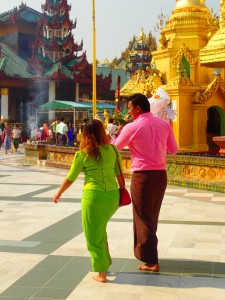
Rangoon : Shwedagon Paya
As soon as our arrival in the airport, we were surprised. Not only the women wore traditional skirt but also the men! In fact, they wear the longyi, a pipe of fabric long until the feet and knot at the waist.
We found the street of Yangon very quite despite of the traffic jams. We quickly realized that there were no motorcycle, amazing for an Asian city! The former dictator would forbidden them in this city after being threatened by a motorcyclist. For us, it was more convenient, it was easier to find a way between the cars. Another surprising fact: people drive on the right side but the wheel is on the right side in almost all the cars. The side would changed about 20 years ago because of superstitions. However, the second-hand cars are still coming from Japan.
Here we were lucky to be hosted by Justine, a french expatriate who was working in Myanmar for a year. With she, we went to Chinatown to see the shows of the Chinese new year. We enjoy first some shellfish. We could choose them when they were still alive and they are cooked in the street. Freshness guaranteed!
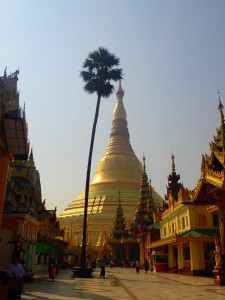
Rangoon : Shwedagon Paya
The main monument in Yangon is the Shwedagon pagoda, it is almost 100 m high and is entirely covered with gold. It attracts a crowd of Buddhist people thanks to its relics. The numerous other pagodas, temples and Buddha statues around make this sacred place very pleasant.
Myanmar is famous for its precious stones. We visited the stone market of Yangon. Fanchon liked some stones but the chance to be fooled was high for someone who was not an expert. Furthermore, in this country, the stones are extracted in very bad environmental and human conditions. She decided not to buy.
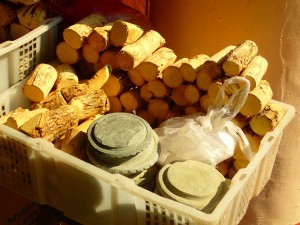
Tanaka
She preferred clothes. We were charmed by the clothing of local people especially the women. They are very elegant from the feet to the head. They use the Tanaka, made from a tree, as solar cream, face-mask and make-up. After they put a very thin layer, they draw some patterns on their face with this yellow powder. Their skirt, called longyi too, is weaved with wonderful patterns and colours. It is often matched with a short-sleeved fitted top.
We found all of these at the covered market for reasonable prices, awesome!
In the country, because of the British colonization, there are Chinese ans Indian people. Indeed, from 1886, Burma was a part of India. Indian people came to settle and to work in the administration. They behaved like second colonists. Despite a very strong Buddhist religion, we saw some Chinese temples, Hindus temples, churches and numerous mosques.
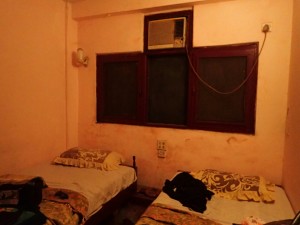
Bago : Chambre glauque | Seedy room
Finally we left Yangon to the countryside. We saw motorcycles and numerous bicycles. We did not feel free, it was forbidden to camp or to sleep at home. We were obliged to go from a city to another city and sleep in hotels. Unfortunately, the accommodation supply was pour and they took advantage of this. The first night was the worst. We ended up in a dirty, hot and humid room with mosquitoes, rubbish beds and the incessant noise of the street for a twice higher price than we paid in Cambodia. Since this night, we decided to pay more if we need but never again!
On the road, we met lot of monks. Their clothing is not orange like in previous countries but burgundy. Many of them are children. A man have to be a monk at least twice in his life. Once before he is 20, once after. We saw also more nuns than in the previous countries.
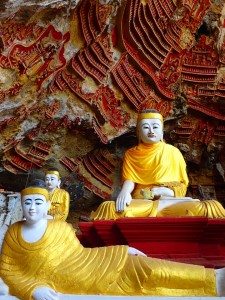
Hpa-an : Statuettes du VIIème siècle | Statuettes of the VIIth century
After 4 days of cycling, we arrived in Hpa-An right in the guest house race. Thanks to our bicycles, we overtook a group of tourists and we found Mélissa who offered to share a room of three beds. Perfect! Hpa-An is famous for the numerous caves in the surroundings. They are all changed in different Buddhist temples. In one of them, there are statuettes of the VIIth century, in another one there is a beautiful lake. The climbing of the Zwegabin mount gave us a memory for a long time: 700 m of height only with steps. Our legs muscles were not prepared. We kept some nice pictures and pains in our calves for a week.
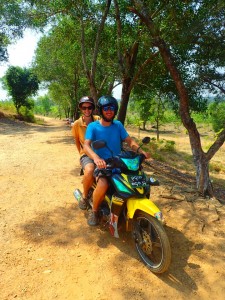 For the first time, we rented a motorcycle to visit the surroundings and for the first time we were arrested by a soldier who took our passport and asked for money. Thanks to a kid, we understood quickly that he was an idiot and we managed easily to get back the passport. Unfortunately, corruption was very common in this country like in many others.
For the first time, we rented a motorcycle to visit the surroundings and for the first time we were arrested by a soldier who took our passport and asked for money. Thanks to a kid, we understood quickly that he was an idiot and we managed easily to get back the passport. Unfortunately, corruption was very common in this country like in many others.
Officially, there are in Myanmar 135 ethnic groups including 8 main groups. The most important (69% of the population) is the Bamar group located in the central valleys where the big cities Mandalay and Yangon are located. Hpa-An is situated in the Kayin state where the Karen people live. The men are recognizable because their longyi looks like the longyi of women: colourful with horizontal patterns. The Karen group is also famous for their independent claims. The next city, Mawlamyine is located in the Mon state. In the past, the Mon people dominated the region. Now, they are not distinct because lot of the Bamar custom come from the Mon tradition.
The country is difficult to rule with this ethnic diversity. Numerous tensions and conflicts exist between the different groups. Probably the most tragic is the fate of the Rohingyas people. This Muslim group living in the Arakan state in the south-west of Myanmar was deprived of its nationality in 1962, becoming stateless. Since 2010, the Rohingyas people are victims of strong violences supported by Buddhist extremists. A part of the population tried to flee to Bangladesh, Indonesia or Malaysia but in very bad conditions, many died by drowning. The famous Aung San Suu Kyi, leader of the democratic movement and holder of the peace Nobel prize was accused to keep quiet about this tragedy.
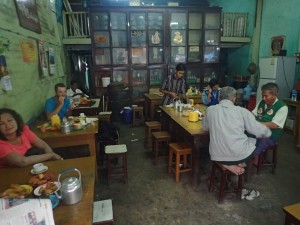
Moulmein : Maison de thé | Tea house
Under the British domination, Mawlamyine was the first capital city. In town, there are many mosques and some old churches. The Buddhist temples are concentrated on a hill which overlooks the town. We visited a wonderful one. It seemed very authentic, for once the sculptures are fine and the finishing touches are meticulous. The neglected courtyard gave it a nice charm.
In this city we liked to go in teahouses. Their ancient aspect charmed us. On the tables, there were always some fries dishes or sweet ready to be enjoyed. By the way, it was often like this in restaurants, we ordered one dish each and get a dozen of plates on the table. We liked the Burmese food, it was a shame that they put the fish sauce everywhere.
Some streets of the city are very wretched. Some people live with nothing. Despite its natural resources, the development of Myanmar is late on its neighbours. The wealth and the power are still in the hand of few people.
We were also appalled by the amount of trashes on the sides of the roads or in the rivers. Myanmar has to work on the cleanliness. For example, we had to take our shoes off before enter in any sacred place but they are sometimes very dirty, we came back with black feet.

Chemin chaotique | Bad road
After riding on a chaotic road reminding Tajikistan, we spent the last night in a good guest house in the town of Kawkareik. Here, electricity was available only after 6 p.m., at the dusk.
In 10 days, we discovered a country where traditions were still very important. Locals are welcoming and the food was good. What a pity that misery and lack of freedom were still there. We will come back!
The 20th of February, we crossed the friendship bridge to come back in Thailand for the third and last time.
